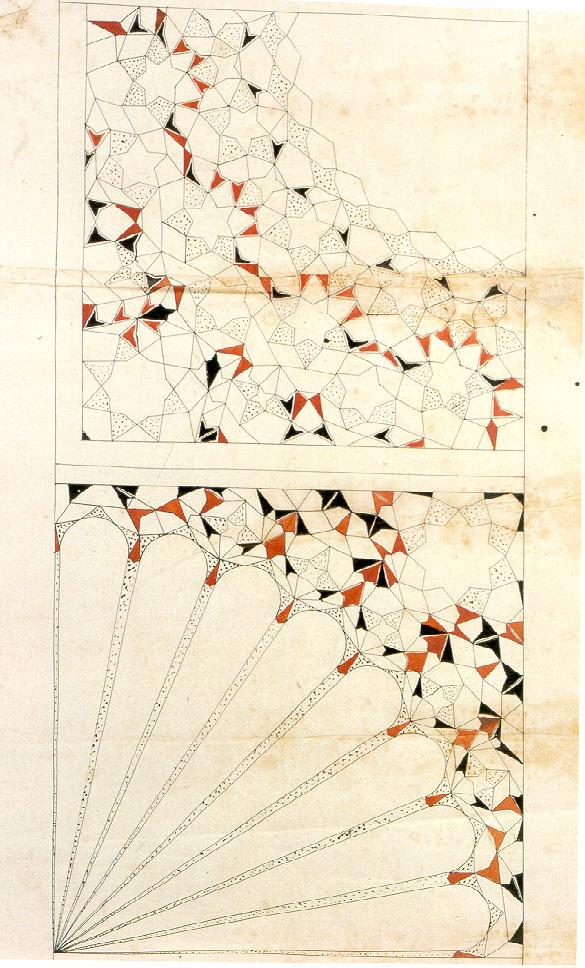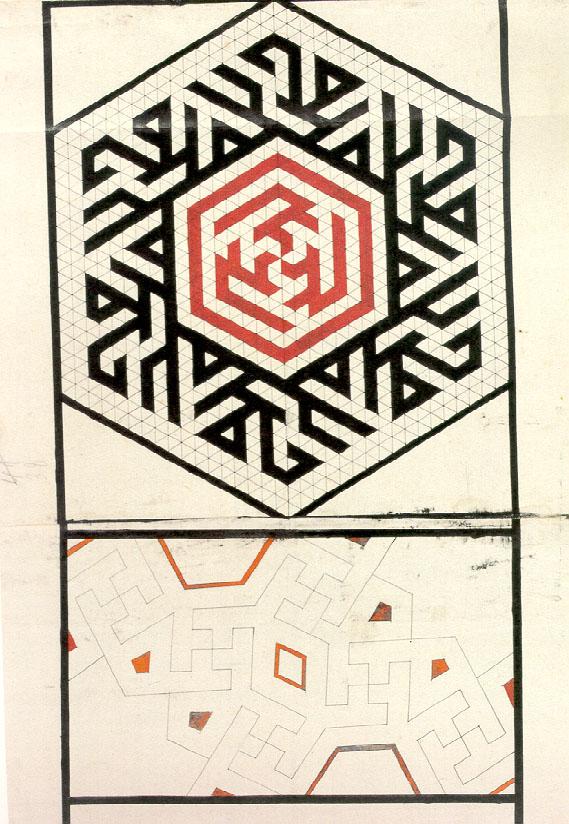Topkapı Scroll on:
[Wikipedia]
[Google]
[Amazon]
 The Topkapı Scroll ( tr, Topkapı Parşömeni) is a
The Topkapı Scroll ( tr, Topkapı Parşömeni) is a
 The scroll consists of 114 geometric patterns drawn in ink and dye. It displays decorative ornaments found on the walls and domes of structures built between the 10th and 16th century in the Timurid dynasty. It was a guidebook for architectural designs seen in complex
The scroll consists of 114 geometric patterns drawn in ink and dye. It displays decorative ornaments found on the walls and domes of structures built between the 10th and 16th century in the Timurid dynasty. It was a guidebook for architectural designs seen in complex  Some of the patterns show the application of geometric principles to Islamic traditions. For example, the word
Some of the patterns show the application of geometric principles to Islamic traditions. For example, the word
The Topkapi Scroll: Geometry and Ornament in Islamic Architecture @ Getty
Animation of Girih pattern development on the Topkapı Scroll
Peter J. Lu and Paul J. Steinhardt, "Decagonal and Quasicrystalline Tilings in Medieval Islamic Architecture," ''Science'' (2007
Utrecht University, Faculty of Science, Department of Mathematics - Seminar Mathematics in Islamic Arts 2010
{{DEFAULTSORT:Topkapi Scroll Timurid dynasty 15th-century manuscripts 16th-century manuscripts Topkapı Palace Islamic art Artists' books Girih Islamic illuminated manuscripts
Timurid dynasty
The Timurid dynasty ( chg, , fa, ), self-designated as Gurkani ( chg, , translit=Küregen, fa, , translit=Gūrkāniyān), was a Sunni Muslim dynasty or clan of Turco-Mongol originB.F. Manz, ''"Tīmūr Lang"'', in Encyclopaedia of Islam, Onl ...
pattern scroll in the collection of the Topkapı Palace
The Topkapı Palace ( tr, Topkapı Sarayı; ota, طوپقپو سرايى, ṭopḳapu sarāyı, lit=cannon gate palace), or the Seraglio, is a large museum in the east of the Fatih district of Istanbul in Turkey. From the 1460s to the complet ...
museum.
The scroll is a valuable source of information, consisting of 114 patterns that may have been used both indirectly and directly by architects to create the tiling patterns in many mosques around the world, including the quasicrystal
A quasiperiodic crystal, or quasicrystal, is a structure that is ordered but not periodic. A quasicrystalline pattern can continuously fill all available space, but it lacks translational symmetry. While crystals, according to the classical ...
Girih tilings from Darb-e Imam
The shrine of Darb-e Imam ( fa, امامزاده درب امام), located in the Dardasht quarter of Isfahan, Iran, is a funerary complex, with a cemetery, shrine structures, and courtyards belonging to different construction periods and styles. ...
.
Physical properties
The Topkapı scroll is a wide scroll of in length, which is unrolled side to side. One end of the scroll is fixed to a wooden roller, and the other end is glued to a protective leather piece. A number ofparchment
Parchment is a writing material made from specially prepared untanned skins of animals—primarily sheep, calves, and goats. It has been used as a writing medium for over two millennia. Vellum is a finer quality parchment made from the skins o ...
pieces featuring various patterns are applied on the scroll. The differences in the border of some drawings indicate that the Topkapı Scroll consists of two different scrolls fixed together. The fact that it is not worn out suggests that it was not made to be used as a reference document in a craftman's workshop, but rather than as an exhibition work in the palace. It was probably a record of tiling works carried out in the palace.
The scroll was made by one person only. Most of the patterns were drawn on two pieces of parchment that were put together, and then pasted on the scroll. The placement of the patterns on the scroll is somewhat disorganized. Patterns of similar themes are fallen apart, and some patterns formed on two parchment pieces are combined imperfectly.
The stamp on the scroll "H1956" indicates that it is registered in the inventory of the Topkapı Palace's Treasury department.
An edition of the scroll was published with an extensive commentary, but it is now out of print.
History
The Topkapı Scroll was presumably prepared in Iran during the Safavid dynasty in the end of the 15th century or beginning of the 16th century. A similarity between some of the patterns on the Topkapı Scroll and a tile panel in the Jame-e Kabir Mosque (grand mosque) inYazd
Yazd ( fa, یزد ), formerly also known as Yezd, is the capital of Yazd Province, Iran. The city is located southeast of Isfahan. At the 2016 census, the population was 1,138,533. Since 2017, the historical city of Yazd is recognized as a Wor ...
indicates that this scroll was created in Tabriz
Tabriz ( fa, تبریز ; ) is a city in northwestern Iran, serving as the capital of East Azerbaijan Province. It is the List of largest cities of Iran, sixth-most-populous city in Iran. In the Quri Chay, Quru River valley in Iran's historic Aze ...
. On the other hand, it is possible that the scroll was made in Shiraz
Shiraz (; fa, شیراز, Širâz ) is the fifth-most-populous city of Iran and the capital of Fars Province, which has been historically known as Pars () and Persis. As of the 2016 national census, the population of the city was 1,565,572 p ...
because it consists of mainly muqarnas
Muqarnas ( ar, مقرنص; fa, مقرنس), also known in Iranian architecture as Ahoopāy ( fa, آهوپای) and in Iberian architecture as Mocárabe, is a form of ornamented vaulting in Islamic architecture. It is the archetypal form of I ...
in the form of a hand-held fan referred by Jamshīd al-Kāshī
Ghiyāth al-Dīn Jamshīd Masʿūd al-Kāshī (or al-Kāshānī) ( fa, غیاث الدین جمشید کاشانی ''Ghiyās-ud-dīn Jamshīd Kāshānī'') (c. 1380 Kashan, Iran – 22 June 1429 Samarkand, Transoxania) was a Persian astronomer ...
as Shirazi. It may have been looted
by the Ottomans after the Ottoman–Safavid War (1578–90).
The muqarnas on the scroll, which are mostly in the form of a hand-held fan, reflect the architectural style of the Timurid dynasty, Turkmen people in Iran and Central Asia. In contrast, the muqarnas in Cairo
Cairo ( ; ar, القاهرة, al-Qāhirah, ) is the Capital city, capital of Egypt and its largest city, home to 10 million people. It is also part of the List of urban agglomerations in Africa, largest urban agglomeration in Africa, List of ...
are in the form of seashell.
The Topkapı Scroll was discovered in 1986. Gülru Necipoğlu of Harvard University
Harvard University is a private Ivy League research university in Cambridge, Massachusetts. Founded in 1636 as Harvard College and named for its first benefactor, the Puritan clergyman John Harvard, it is the oldest institution of high ...
published a book, which describes the scroll with copies of its patterns. The book was translated into Persian language
Persian (), also known by its endonym Farsi (, ', ), is a Western Iranian language belonging to the Iranian branch of the Indo-Iranian subdivision of the Indo-European languages. Persian is a pluricentric language predominantly spoken a ...
by Mihrdad Kayyumi Bidhind under the title ''Handasa va Tazyin dar Mi‘mari-yi Islami: Tomar-i Topkapı'' (Tahran, Kitabkhana-yi Milli-yi Iran, 1379).
Content
muqarnas
Muqarnas ( ar, مقرنص; fa, مقرنس), also known in Iranian architecture as Ahoopāy ( fa, آهوپای) and in Iberian architecture as Mocárabe, is a form of ornamented vaulting in Islamic architecture. It is the archetypal form of I ...
, girih
''Girih'' ( fa, گره, "knot", also written ''gereh'') are decorative Islamic geometric patterns used in architecture and handicraft objects, consisting of angled lines that form an interlaced strapwork pattern.
''Girih'' decoration is beli ...
, mosaic panels and colorful tiles. The scroll does not mention how those patterns are constructed, and has no date or signature.
The two-dimensional figures make it unclear how they can be employed to three-dimensional ornamental objects.
One of the characteristics of the Topkapı Scroll is that it includes Arabic calligraphy
Arabic calligraphy is the artistic practice of handwriting and calligraphy based on the Arabic alphabet. It is known in Arabic as ''khatt'' ( ar, خط), derived from the word 'line', 'design', or 'construction'. Kufic is the oldest form of t ...
called square or geometric Kufic. This script type was seen for the first time in the state of Ilkhanate
The Ilkhanate, also spelled Il-khanate ( fa, ایل خانان, ''Ilxānān''), known to the Mongols as ''Hülegü Ulus'' (, ''Qulug-un Ulus''), was a khanate established from the southwestern sector of the Mongol Empire. The Ilkhanid realm ...
, and it was presumably created in inspiration from Chinese character
Chinese characters () are logograms developed for the writing of Chinese. In addition, they have been adapted to write other East Asian languages, and remain a key component of the Japanese writing system where they are known as ''kanj ...
s in rectangular form. One of the patterns on the Topkapı Scroll, which matches an existing architectural structure, is the Kufic script drawn for banna'i
In Iranian architecture, banna'i ( fa, بنائی, "builder's technique" in Persian) is an architectural decorative art in which glazed tiles are alternated with plain bricks to create geometric patterns over the surface of a wall or to spell ou ...
, in which tiles are alternated with plain bricks to create geometric patterns over the surface of a wall. Almost exactly the same of this pattern is found on the gate of a mosque in Varzaneh.
Muhammad
Muhammad ( ar, مُحَمَّد; 570 – 8 June 632 CE) was an Arab religious, social, and political leader and the founder of Islam. According to Islamic doctrine, he was a prophet divinely inspired to preach and confirm the mo ...
(Muḥammad ibn ʿAbd Allāh) is repeated six times along the sides of the hexagon
In geometry, a hexagon (from Greek , , meaning "six", and , , meaning "corner, angle") is a six-sided polygon. The total of the internal angles of any simple (non-self-intersecting) hexagon is 720°.
Regular hexagon
A '' regular hexagon'' has ...
, and the word Ali
ʿAlī ibn Abī Ṭālib ( ar, عَلِيّ بْن أَبِي طَالِب; 600 – 661 CE) was the last of four Rightly Guided Caliphs to rule Islam (r. 656 – 661) immediately after the death of Muhammad, and he was the first Shia Imam ...
(Alī ibn Abī Ṭālib) three times in a rotating wise in the inner hexagon.
One pattern on the scroll consists of nine-pointed and eleven-pointed geometric star figures, and other one thirteen-pointed and sixteen-pointed geometric star figures. In the Islamic art
Islamic art is a part of Islamic culture and encompasses the visual arts produced since the 7th century CE by people who lived within territories inhabited or ruled by Muslim populations. Referring to characteristic traditions across a wide ra ...
, this sort of stars were developed by folding certain patterns along the sides of a square.
Some of the drawings on the scroll are formed by overlapped patterns of different scales. This feature is seen frequently in Islamic architecture
Islamic architecture comprises the architectural styles of buildings associated with Islam. It encompasses both secular and religious styles from the early history of Islam to the present day. The Islamic world encompasses a wide geographic ...
. Detailed patterns within an ornament appear when one gets closer to a building with figures, which are difficult to perceive from the distance.
References
External links
The Topkapi Scroll: Geometry and Ornament in Islamic Architecture @ Getty
Animation of Girih pattern development on the Topkapı Scroll
Peter J. Lu and Paul J. Steinhardt, "Decagonal and Quasicrystalline Tilings in Medieval Islamic Architecture," ''Science'' (2007
Utrecht University, Faculty of Science, Department of Mathematics - Seminar Mathematics in Islamic Arts 2010
{{DEFAULTSORT:Topkapi Scroll Timurid dynasty 15th-century manuscripts 16th-century manuscripts Topkapı Palace Islamic art Artists' books Girih Islamic illuminated manuscripts